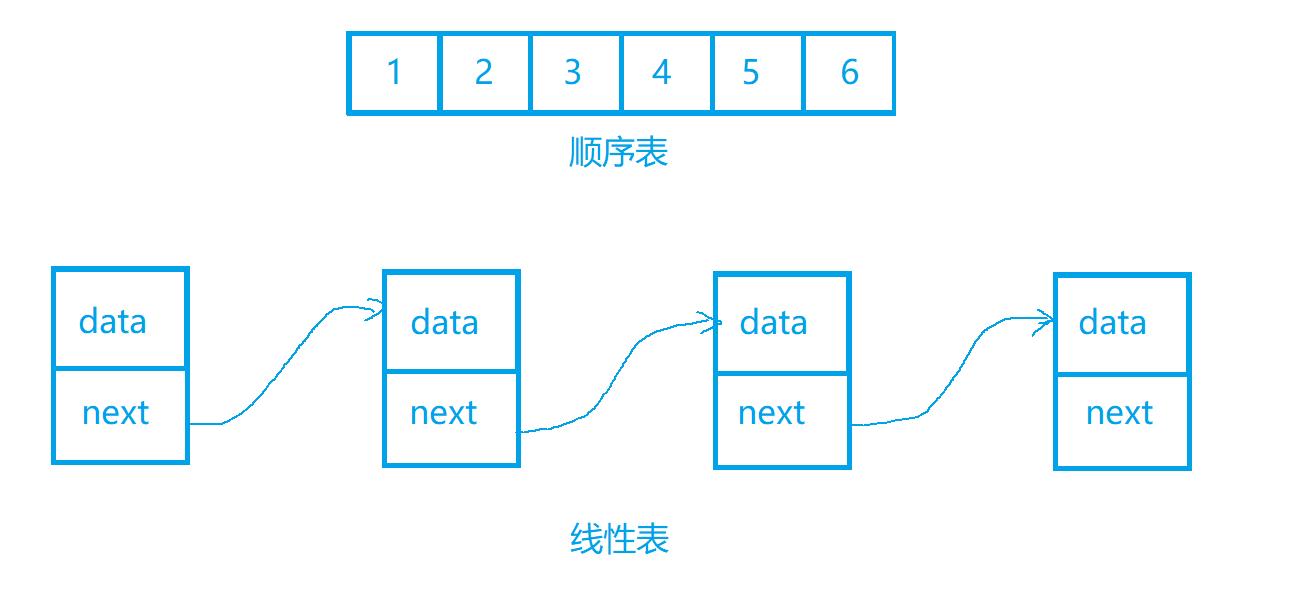数据结构---顺序表单链表
Posted 你帅你先说.
tags:
篇首语:本文由小常识网(cha138.com)小编为大家整理,主要介绍了数据结构---顺序表单链表相关的知识,希望对你有一定的参考价值。
●🧑个人主页:你帅你先说.
●📃欢迎点赞👍关注💡收藏💖
●📖既选择了远方,便只顾风雨兼程。
●🤟欢迎大家有问题随时私信我!
●🧐版权:本文由[你帅你先说.]原创,CSDN首发,侵权必究。
🐩1.线性表
线性表(linear list)是n个具有相同特性的数据元素的有限序列。 线性表是一种在实际中广泛使用的数据结构,常见的线性表:顺序表、链表、栈、队列、字符串…
线性表在逻辑上是线性结构,也就说是连续的一条直线。但是在物理结构上并不一定是连续的,线性表在物理上存储时,通常以数组和链式结构的形式存储。

🐒2.顺序表
🐎2.1概念及结构
顺序表是用一段物理地址连续的存储单元依次存储数据元素的线性结构,一般情况下采用数组存储。在数组上完成数据的增删查改。
顺序表一般可以分为:
- 静态顺序表:使用定长数组存储元素。
- 动态顺序表:使用动态开辟的数组存储。
🐈2.2接口实现
静态顺序表只适用于确定知道需要存多少数据的场景。静态顺序表的定长数组导致N定大了,空间开多了浪费,开少了不够用。所以现实中基本都是使用动态顺序表,根据需要动态的分配空间大小,所以下面我们实现动态顺序表。
typedef int SLDataType;
// 顺序表的动态存储
typedef struct SeqList
{
SLDataType* array; // 指向动态开辟的数组
size_t size ; // 有效数据个数
size_t capicity ; // 容量空间的大小
}SeqList
🐢2.2.1初始化顺序表
void SeqListInit(SL* ps)
{
ps->a = NULL;
ps->size = ps->capacity = 0;
}
🐳2.2.2打印顺序表
void SeqListPrint(SL* ps)
{
for (int i = 0; i < ps->size; ++i)
{
printf("%d ", ps->a[i]);
}
printf("\\n");
}
🐝2.2.3检查空间余量
void SeqListCheckCapacity(SL* ps)
{
// 如果没有空间或者空间不足,那么我们就扩容
if (ps->size == ps->capacity)
{
int newcapacity = ps->capacity == 0 ? 4 : ps->capacity * 2;
SLDataType* tmp = (SLDataType*)realloc(ps->a, newcapacity*sizeof(SLDataType));
if (tmp == NULL)
{
printf("realloc fail\\n");
exit(-1);
}
ps->a = tmp;
ps->capacity = newcapacity;
}
}
🐬2.2.4顺序表尾插
void SeqListPushBack(SL* ps, SLDataType x)
{
SeqListCheckCapacity(ps);
ps->a[ps->size] = x;
ps->size++;
}
🐙2.2.5顺序表尾删
void SeqListPopBack(SL* ps)
{
assert(ps->size > 0);
ps->size--;
}
🦉2.2.6顺序表头插
void SeqListPushFront(SL* ps, SLDataType x)
{
SeqListCheckCapacity(ps);
// 挪动数据
int end = ps->size - 1;
while (end >= 0)
{
ps->a[end + 1] = ps->a[end];
--end;
}
ps->a[0] = x;
ps->size++;
}
🦜2.2.7顺序表头删
void SeqListPopFront(SL* ps)
{
assert(ps->size > 0);
// 挪动数据
int begin = 1;
while (begin < ps->size)
{
ps->a[begin - 1] = ps->a[begin];
++ begin;
}
ps->size--;
}
🐘2.2.8查找下标
int SeqListFind(SL* ps, SLDataType x)
{
for (int i = 0; i < ps->size; i++)
{
if (ps->a[i] == x)
{
return i;
}
}
return -1;
}
🐿️2.2.9指定位置插入
void SeqListInsert(SL* ps, int pos, SLDataType x)
{
assert(pos >= 0 && pos <= ps->size);
SeqListCheckCapacity(ps);
// 挪动数据
int end = ps->size - 1;
while (end >= pos)
{
ps->a[end + 1] = ps->a[end];
--end;
}
ps->a[pos] = x;
ps->size++;
}
🐇2.2.10指定位置插入
void SeqListErase(SL* ps, int pos)
{
assert(pos >= 0 && pos < ps->size);
int begin = pos + 1;
while (begin < ps->size)
{
ps->a[begin - 1] = ps->a[begin];
++begin;
}
ps->size--;
}
🐉2.2.11顺序表销毁
void SeqListDestory(SL* ps)
{
free(ps->a);
ps->a = NULL;
ps->capacity = ps->size = 0;
}
🐅3.单链表
🦌3.1概念
概念:链表是一种物理存储结构上非连续、非顺序的存储结构,数据元素的逻辑顺序是通过链表中的指针链接次序实现的 。

这是单链表的逻辑结构,是我们假想出来的,方便我们理解。而链表的物理结构也就是真实的样子其实是这样的。

🐆3.2接口实现
typedef int SLTDateType;
typedef struct SListNode
{
SLTDateType data;
struct SListNode* next;
}SLTNode;
从上面那张图我们知道单链表是通过存下一个结点的地址来进行访问的。
所以单链表要访问下一个结点的操作是这样的
SLTNode* Node;
Node = Node->next;
搞清楚了这个,接下来的接口实现你才能理解
🐂3.2.1创建结点
SLTNode* BuyListNode(SLTDateType x)
{
SLTNode* newnode = (SLTNode*)malloc(sizeof(SLTNode));
if (newnode == NULL)
{
printf("malloc fail\\n");
exit(-1);
}
newnode->data = x;
newnode->next = NULL;
return newnode;
}
🐖3.2.2单链表尾插
void SListPushBack(SLTNode** pphead, SLTDateType x)
{
SLTNode* newnode = (SLTNode*)malloc(sizeof(SLTNode));
newnode->data = x;
newnode->next = NULL;
if (*pphead == NULL)
{
*pphead = newnode;
}
else
{
SLTNode* tail = *pphead;
while (tail->next != NULL)
{
tail = tail->next;
}
tail->next = newnode;
}
}
🐓3.2.3单链表尾删
void SListPopBack(SLTNode** pphead)
{
assert(*pphead != NULL);
// 1、一个节点
// 2、两个及以上节点
if ((*pphead)->next == NULL)
{
free(*pphead);
*pphead = NULL;
}
else
{
SLTNode* tail = *pphead;
while (tail->next->next)
{
tail = tail->next;
}
free(tail->next);
tail->next = NULL;
}
}
🐤3.2.4单链表头插
void SListPushFront(SLTNode** pphead, SLTDateType x)
{
SLTNode* newnode = BuyListNode(x);
newnode->next = *pphead;
*pphead = newnode;
}
🐦3.2.5单链表头删
void SListPopFront(SLTNode** pphead)
{
//if (*pphead == NULL)
// return;
assert(*pphead != NULL);
SLTNode* next = (*pphead)->next;
free(*pphead);
*pphead = next;
}
🐧3.2.6单链表打印
void SListPrint(SLTNode* phead)
{
SLTNode* cur = phead;
while (cur != NULL)
{
printf("%d->", cur->data);
cur = cur->next;
}
printf("NULL\\n");
}
🦢3.2.7寻找结点
SLTNode* SListFind(SLTNode* phead, SLTDateType x)
{
SLTNode* cur = phead;
while (cur)
{
if (cur->data == x)
{
return cur;
}
else
{
cur = cur->next;
}
}
return NULL;
}
🦚3.2.8指定位置前插入
void SListInsert(SLTNode** pphead, SLTNode* pos, SLTDateType x)
{
SLTNode* newnode = BuyListNode(x);
if (*pphead == pos)
{
newnode->next = *pphead;
*pphead = newnode;
}
else
{
// 找到pos的前一个位置
SLTNode* posPrev = *pphead;
while (posPrev->next != pos)
{
posPrev = posPrev->next;
}
posPrev->next = newnode;
newnode->next = pos;
}
}
🦩3.2.9指定位置后插入
void SListInsertAfter(SLTNode* pos, SLTDateType x)
{
assert(pos);
SLTNode* newnode = BuyListNode(x);
newnode->next = pos->next;
pos->next = newnode;
}
🐙3.2.10指定位置删除
void SListErase(SLTNode** pphead, SLTNode* pos)
{
assert(pphead);
assert(pos);
if (*pphead == pos)
{
SListPopFront(pphead);
}
else
{
SLTNode* prev = *pphead;
while (prev->next != pos)
{
prev = prev->next;
}
prev->next = pos->next;
free(pos);
//pos = NULL;
}
}
🐞3.2.11指定位置后删除
void SListEraseAfter(SLTNode* pos)
{
assert(pos);
assert(pos->next);
SLTNode* next = pos->next;
pos->next = next->next;
free(next);
}
🦘3.2.12单链表销毁
void SListDestory(SLTNode** pphead)
{
assert(pphead);
SLTNode* cur = *pphead;
while (cur)
{
SLTNode* next = cur->next;
free(cur);
cur = next;
}
*pphead = NULL;
}
🐕🐕🐕🐕🐕🐕🐕🐕🐕🐕🐕🐕🐕🐕🐕🐕
这样的文章你还不快 点赞👍关注💡收藏💖
🐈🐈🐈🐈🐈🐈🐈🐈🐈🐈🐈🐈🐈🐈🐈🐈

以上是关于数据结构---顺序表单链表的主要内容,如果未能解决你的问题,请参考以下文章